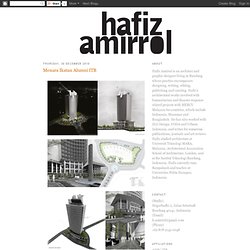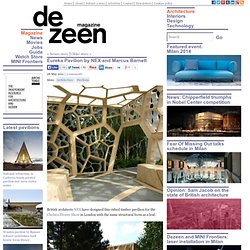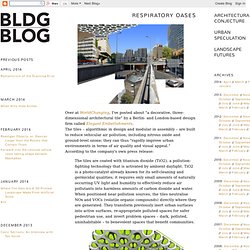

Architecture Competitions, Architectural Prizes, Design Contests, Architecture Student Competitions. SuckerPUNCH. Dezeen architecture and design magazine. Daily Icon - Part 37. Northwest Peach Farm by Bates Masi Architects This residence is primarily used when the clients’ extended family comes from England for long visits.
They come to relax and to reconnect with their family and with nature, away from city crowds and traffic, at a retreat they neither want nor need to leave for a month. The design objective was to make every day of that month unique by providing a range of destinations within the site with diverse scales, functions, and views: from gathering in the expansive living room overlooking the fields of the former peach orchard to reading alone on a shaded bench between the library and the edge of the forest. Multiple paths and hallways connect each destination, further increasing variety. Finally, each detail and custom furnishing is designed to make mundane rituals into thoughtful events.
Northwest Peach Farm, East Hampton, NY, USA, by Bates Masi Architects, Photography by Michael Moran Photography via: Arch Daily Island House by WRB Architects. December 2010. Urbanization in Indonesia Rapid urban growth and the emergence of city areas are becoming the new phenomena in Indonesia (Gardiner, 2006).

In understanding Indonesia’s urbanization, we cannot escape from the fact that it is largely affected by socio-economic development process. Industrialized countries such as North America, Western Europe, Japan and Australia have high proportion of urbanized population compared to most developing countries. Newly industrialized countries such as South Korea, Singapore and Malaysia have witnessed solid transition towards a more urbanized society, while in contrasts, developing countries such as Indonesia have a relatively lower level of urbanization. This chapter will discuss the urbanization phenomenon in Indonesia and Bandung city in general, by focusing on the reality of dualism that happens almost in all urbanized area in Indonesia. Urbanization is a process of transformation from rural to an industrialized lifestyle (Firman, 2007).
Studio Banana interviews Toyo Ito. Nico Saieh. Comunidad abierta de arquitectura, construcción y diseño arqa.com » Comunidad abierta de arquitectura, construcción y diseño. BUFETE TÉCNICO - Portal de Arquitectura · Revista Online para Arquitectos. Eureka Pavilion by NEX and Marcus Barnett. British architects NEX have designed this cubed timber pavilion for the Chelsea Flower Show in London with the same structural form as a leaf.

Between the gaps in the timber capillaries are smaller framework elements made from recycled plastic, curved to resemble leaf cells. When Chelsea Flower Show ends this weekend, the Eureka Pavilion will be moved to Kew Gardens for the summer season. More stories about pavilions on Dezeen » The following details are from the architects: NEX complete innovative ‘bio-mimicry’ design for The Times Eureka Pavilion at Chelsea Flower Show.
NEX is delighted to contribute to creating a benchmark in integrated design at this year’s RHS Chelsea Flower Show (Tuesday May 24th to Saturday May 28th) working with Buro Happold and Chelsea Gold Medallist Marcus Barnett on the creation of a pavilion for The Times Eureka Garden, in association with the Royal Botanic Gardens, Kew. Click above for larger image. Respiratory Oases. Over at WorldChanging, I've posted about "a decorative, three-dimensional architectural tile" by a Berlin- and London-based design firm called Elegant Embellishments.

The tiles – algorithmic in design and modular in assembly – are built to reduce vehicular air pollution, including nitrous oxide and ground-level ozone; they can thus "rapidly improve urban environments in terms of air quality and visual appeal. "According to the company's own press release:The tiles are coated with titanium dioxide (TiO2), a pollution-fighting technology that is activated by ambient daylight. TiO2 is a photo-catalyst already known for its self-cleaning and germicidal qualities; it requires only small amounts of naturally occurring UV light and humidity to effectively reduce air pollutants into harmless amounts of carbon dioxide and water.
When positioned near pollution sources, the tiles neutralise NOx and VOCs (volatile organic compounds) directly where they are generated.